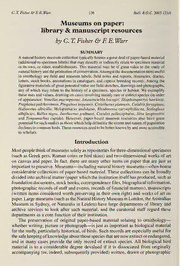
Museums on paper: Library & manuscript resources PDF
Preview Museums on paper: Library & manuscript resources
— C.T.Fisher&F.E.Warr 136 Bull.B.O.C.2003123A Museums on paper: library & manuscript resources by C. T.Fisher &EE.Warr SUMMARY Anaturalhistorymuseumcollectiontypicallyhousesagreatdealofpaper-basedmaterial (additionaltospecimenlabels)thatmaydirectlyorindirectlyrelatetospecimenmaterial initsown,orother,establishments.Thismaterialmaybeofgreatvaluetothestudyof naturalhistoryandthepromotionofconservation.Amongstthedocumentationmostuseful inornithologyarefieldandmuseumlabels,fieldnotesandreports,itineraries,diaries, letters,stockbooks,annotationsincatalogues,andcaptivebreedingrecords.Amongthe figurativematerialsofgreatpotentialvaluearefieldsketches,drawingsandphotographs, anyofwhichmayrelatetothehistoryofaspecimen,speciesorhabitat.Weexemplify theseusesandvalues,drawingoncasesinvolvingmainlyrareorextinctspecies(inorder ofappearance:Vanellusmacropterus,Amaurocichlabocagei,Diaphorapteryxhawkinsi, Psephotuspulcherrimus,Pinguinusimpennis,Cistothorusplatensis,Calidrisferruginea, Haliaeetusalbicilla,Melopsittacusundulatus,Rhodonessacaryophyllacea,Sceloglaux albifacies,Rallusnigra,Janthoenasgodmani,Cuculuspoliocephalus,Sittalongirostris and Tympanuchus cupido). However, paper-basedmuseumresources alsohave great potentialforsuchstudiesasthosewhichhelpdelineatetheextentandnatureofpopulation declinesincommonbirds.Theseresourcesneedtobebetterknownbyandmoreaccessible toscholars. Introduction Mostpeoplethinkofmuseumssolelyasrepositoriesforthree-dimensionalspecimens (suchasGreekpots,Romancoinsorbirdskins)andtwo-dimensionalworksofart oncanvas andpaper. Infact, th—erearemanyotheritems onpapert—hatarejustas importanttopreserve.Museums includingnaturalhistorymuseums oftenhouse considerablecollectionsofpaper-basedmaterial.Thesecollectionscanbebroadly dividedintoarchivalmatter(paperwhichtheinstitutionitselfhasproduced,suchas foundationdocuments,stockbooks,correspondencefiles,biographicalinformation, photographicrecordsofstaffandevents,recordsoffinancialmatters),manuscripts (writtenitemsconsideredworthpreservingintheirownright)andworksofarton paper.Largemuseums(suchastheNaturalHistoryMuseuminLondon,theAustralian MuseuminSydney,orNaturalisinLeiden)havelargedepartmentsoflibraryand archive services to look after such material, andthe curatorial staffregardthese departmentsasacorefunctionoftheirinstitution. The preservation oforiginal paper—-based material relating to ornithology whetherwriting,pictureorphotograph isjustasimportantasbiologicalmaterial forthestudy,particularlyhistorical,ofbirds.Suchrecordsareespeciallyusefulfor thesafekeepingofknowledgeaboutthosespeciesthatarenowextinctorendangered, andinmany casesprovide theonlyrecordofextinct species.Allbiologicalbird material is to a considerable degree devalued ifit is dissociated from originally accompanying(or,indeed,subsequentlyprovided)written,drawnorphotographic .. C.T.Fisher&FE.Warr 137 Bull.B.O.C.2003123A material.Inthispaperweidentifyandillustratesomeofthetypesofcontributionto ornithologyandconservationmadebythepaperarchivesmaintainedbymuseums. Writtenmaterial Amongstthe writtenmaterials mostuseful in ornithology are: field and museum labels,fieldnotesandreports,itineraries,diaries,letters,stockbooksandannotations in catalogues, and captive breeding records. Inthis essay we largely assume the crucial importance ofensuring the permanent attachment and good condition of originalspecimenlabelsasameansofverifyingandevaluatingspecimenmaterial, butwedo alludetocases whichdemonstratethisparticulartruth. Itis alsotobe notedthatthepreservationandimprovementoflabelconditionarewellworthyof thecloseattentionofthemuseumcuratorialcommunity.Wealsoassumetheobvious necessityofregardingbiologicalfieldrecordsasspecimensintheirownright,and wouldliketoemphasisethatwhentheseareoncomputer,ratherthanonfilecards, itisneverthelessbothpracticalandprecautionarytokeephardcopies,sincemembers ofthe public may not always have computer access at the time oftheir visit. Furthermore,weassumethattheneedforanaccurateanddetailedpapercatalogue orregisterofallspecimenmaterialinaparticularinstitutionisacknowledgedand understood (althoughitis apparentthatthedevelopmentofsuchdocuments into computerised format remains a challenge ofvery considerable dimensions, as it doesforotherpaper-basedmaterials).Forthemostpartweusethisessaytofurnish somenoteworthyexamplesofhowpaper-basedmaterialshaveyieldedsignificant piecesofinformationinornithology. Fieldnotes,L'BartelsonthejavanLapwing MaxE.G.BattelswasaplantationowneronJavawhohadagreatloveofbirdsboth inthewildandintheaviary.Hisdetailedfieldnotebooks,writtenbetween1915and 1931, areheldintheRijksmuseumvanNatuurilijkeHistorie (Naturalis), Leiden, theNetherlands.Bartels'snotesincludeanaccountoftheJavanLapwing Vanellus macropterus,whichispossiblynowextinct.Thisistheonlyknownfielddescription ofthespecies,withoutwhichabsolutelynothingwouldotherwisebeknownaboutit inthelivingstate.Thisaccounthasbeenrecentlypublished(Collaretal.2000)but someextractsfollow: Xiphidiopteruscucullatus,Temm. The areaofdistribution ofthis SpurredLapwing inJavais veryrestricted ... found...onlyintheextensivesteppe-likeswampsoftheSedariestuaryandits tributaries, as well as... inthe lowlands oftheTjitaroemdeltaand atRawah Tangerang... [where] itisaneverydaysight,impossibletomiss...Astheyare cleverandverycautiousbirds, theyneverdive-bombpeoplebutinsteadthey generally'createastink'atanappropriatedistance...Duringtheeastmonsoon.. theyundoubtedlypreferthepatcheswhere[Teki]grassesstaymoistthelongest.. Duringtherainyseasonthebirdskeeptoareasintheswampswhicharerelatively littleflooded,sincedespitetheirlonglegstheyprefernottowalkinopenwater A C.T.Fisher&FE.Warr 138 BullB.O.C.2003123 likestilts.IntheTjitaroemdeltatheyoftenbusythemselvesinwetcattlepasture atthebordersoftheirnormalforagingareas,whicharedenselyovergrownswamps withrush/sedgeandothershorterwaterplants... Theirfoodconsistsmainlyof water-orswamp-livinginsectlarvae,waterbugs,beetles,snails... andseedof aquaticplants... (Fig. 1). rs2U3 -:'KXjz,;^::z^yrn uas ,'eror xn aen des Se-1 «:^ Figure1.AccountoftheJavanLapwing,fromMaxBartels'fieldnotes(©Naturalis.Leiden). C.T.Fisher&FE.Warr 139 Bull.B.O.C.2003 123A Fieldnotes,2:CorreiaandtheSaoTomeShort-tail Whenworkingon ThreatenedbirdsofAfricaandrelatedislands(Collar&Stuart 1985),N.J.CollarnoticedthatDavidBannerman,inBirdsoftheAtlanticislands, maderepeatedreferencetonotesonspeciesmadebyJ.G.Correiaduringcollecting workheundertookfortheAmericanMuseumofNaturalHistoryontheAzoresand CapeVerdes.In 1928-1929C—orreiahadalsocollectedontheislandsofSaoTome andPrincipe(Amadon 1953) islandsofimmenseimp—ortancetoconservationyet intheearly 1980sstillvirtuallyunknownbiologically soCollar(verbally 1999) made inquiries atAMNH whether.Correiahad left any notes there on his work. InitiallyMaryLeCroywasunabletofindanything,buteventuallyatypescriptcame tolightinDeanAmadon'sdeskandwascopiedtoCollarforhisuse.Thevalueof this typescriptis to some extentlimitedby the factthatCorreia, understandably, was not entirely sure ofwhat he was seeing, and so named the birds he saw in accordancewithhissenseofwhattheymightbe('Yellow-belliedFlycatcher'and soon).Nevertheless,oncethesenamescanbeidentifiedwithcompleteconfidence, byrelatingdatesinthetypescripttodatesonspecimenlabels,themanuscripthas greatpotentialtoilluminatespecies'formerabundanceandhabits. Perhaps the most remarkable entry in the typescript concernsAmaurocichla bocagei,towhichCollar&Stuart(1985)gavethenameSaoTomeShort-tail,since no-onethenwasverysurewhatitwas(althoughtheAbbeRenedeNauroishadjust sentCollaramanuscriptinwhichheproposedthepossibilitythatthespecieswas the OldWorld's only furnariid).Atthe time ofCorreia's visit, thebird was only knownfromthreenineteenth-centuryspecimens,anditwasonlybyobtainingthe datesofthespecimensCorreiacollectedandmatchingthemtohisnotebookentries thatitwaspossibletoidentifythe subjectoftheentry. Hisentryfor4December 1928(reproducedexactlyastyped)showthatthebirddidindeedpresentastriking problemoftaxonomicplacement: Noraininthemorningbutdarkweather;IwentuptotheObo(forest)formy goodluckI foudn two newbirds to-day Rail, a new bird forme and forthe residentesofthesepartoftheislandwhichtoldmethattheyasneverseensuch birdyet.TheRailisaverysmallbirdthebackisdullybrownandthebellyis ruffsbrownveryshirttailbutlitlelonglegswithlongtoetoo.Ifounditsonthe creekquiteattheheadoftheRioQuija,itswasonthesmallstonesinthecentre ofthecreeklookingforsomethingamongthesand,whenIshotthefirstanother tookashortflightandrestdonadrylimbrightamongthestonessoIshotittoo. Itsweremaleandfamely.IshotoneYellow-belly,oneOssobo,andthreelarge honey-eatersallintheOboexcpettheOssobo. Ofcoursethespeciesisnotarail(itappearstobeanaberrantsylviid).However, Correia'sobservationsofitsrail-likebehaviourwereanimportantinsightintoits ecologyandhelpedguideresearcherswhentheybecamethefirstpeoplesinceCorreia (and,atthattime,theonlyotherslastcentury)toseethespeciesinthewild(Atkinson etal. 1991). A C.T.Fisher&FE.Warr 140 BullB.O.C.2003123 Itineraries Itisobviouslyimperativeforcollectorstokeepaccuraterecordsofwhereandwhen specimenswerecollectedinthefield,andthatthesedataarepermanentlyattached tothespecimen.Eighteenth-andnineteenth-centuryspecimensonthewholelack this depth ofinformation, anditis oftenonlybyrecourse to originaldiaries and expedition reports that information can be reunited with specimens. Conversely, labels with datacanbe very usefully employed to create adiary foran explorer wherethisdoesnotexist,orhasbeenlost.IntheVictorianperiod,inparticular,the customwas fordispersal ofspecimens from aparticularexpeditionto museums aroundtheworld(inessencetowhomsoeverwouldpayforthem).Databasingthe localityanddatesonthesespecimens,aftersearchingthemoutinthemanymuseums which contain good Victorian natural history collections, can give unexpectedly positiveresults.Thesearenotonlyofbiographicalinterest:Australians,forinstance, have foundthe database anditinerary compiledby the Liverpool Museum about John Gilbert's travels inAustralia between 1838 and 1845 (housed in computer form,asacardindexandasnumerousnotesandphotocopies,whichindeedfillthe shelvesofonewholeoffice)essentialforconfirmingexactlywherehehadcollected someofhisrarestspecies(seebelow).Inmanycasesaspecimenwithamissingor obscured collecting date can be checked against another with the same locality; converselyspecimenswithdatesbutnolocalitiescanbereunitedwithplacenames whencomparedtootherspecimenscollectedonthesameday(Fig.2). Rasmussen & Prys-Jones (2003, this issue) alsorefer (in their section 'Label substitution')totheusearchivalmaterialcanmakeindeterminingprovenanceof suspectmaterial (e.g. Meek's 'Misima'material) andtothefrustrationofscience thatresultsfromthelossofarchivalmaterial(e.g.theill-considereddestructionof manyofRothschild'spapers). Letters:DannefaerdontheGiantChathamIslandRail TheGiantChathamIslandRailDiaphorapteryxhawkinsiisonlyknownfromfossil bonesfirstcollectedin1892byW.Hawkins(forwhomthebirdisnamed).However, a letter (from Auckland, dated 21 February 1895) held in the Rothschild Correspondence archive at the Natural History Museum, London, from Sigvard DannefaerdtohisemployerWalterRothschild,includesuniqueobservationsonthe living rail and otherbird species that Dannefaerd gleaned second-hand during a visittothenativeChathamIslandMorioris.TheGiantRailbecameextinctbefore thearrivalofEuropeansinthemid-1800s,butobviouslycoexistedwiththeMoriori forsometime.However,theabundanceofitsremainsinMoriorimiddensindicates thatitwasfrequentlyhuntedasfood,aninterpretationcorroboratedemphatically by the information in Dannefaerd's letter. Afull description ofthe letter and its significanceisbeingpreparedbyJoanneCooperoftheNaturalHistoryMuseum, Tring,aspartofawidersurveyofRothschild'sChathamislandcollections.Thereis an artist's reconstruction ofthe Giant Chatham Rail in Gill & Martinson (1991: Figure18),andacompleteskeletonofabirdcollectedbyDannefaerdforRothschild wasillustratedinAndrews(1896:plateXII). C.T.Fisher&EE.Warr 141 BullB.O.C.2003123A Figure2.PartofJohnGilbert'sitineraryinAustralia,reconstructedfromspecimenlabels,letters,diaries andpublishedaccounts(fromFisher1992,©NMGM). A . C.T.Fisher&FE.Warr 142 Bull.B.O.C.2003123 This is not the only scientifically interesting letter amongst Dannefaerd's correspondence,whichisalsogreatlyrevealingabouthowextensiveDannefaerd's previouslyunrecognisedcontributiontoRothschild'sfossilcollectionwas. Lettersandfieldlabels:Gould,GilbertandtheParadiseParrot TheParadiseParrotPsephotuspulcherrimuswasfirstcollectedontheDarlingDowns ofsouthern Queensland by John Gilbert, John Gould's collector inAustralia, in May 1844.GilbertwrotetotellGouldabouthisnewbird,whichisnowthoughtto beextinct(Brooks2000).ThestoryofGilbert'sdiscoveryisnowknownonlybecause ofthefindingoftwoletters,thefirstin 1938.Thiswasadraft1ofGould'sreplyto Gilbert's letter, found in an old trunkbelonging to Gould's descendants. In this letterGouldexclaimedTamespeciallydelightedaboutthenewPlatycercus ..' Since then it has been suspected that Gould had used Gilbert's account, as containedinhisoriginal,butlost,letter,tohelpcomposethetypedescriptionofthe ParadiseParrot(Gould 1845).Luckily,acopyofGilbert'soriginalletterwasquite recentlyfoundinLiverpoolCityLibraries2(Fisher1985)(Fig.3).Thecopywasby the13thEarlofDerby,anardentamateurornithologis—t,towhomGouldwashoping tosellsomespecimensofthisspectacularnewparrot hencehehadobviouslylent Gilbert'slettertoLordDerbyasanencouragement.LordDerbywasaninveterate copierofletters (many into copybooks, althoughthis copy is loose) butwas not always punctilious about returning them. It seems he never sent the original of Gilbert'sletterbacktoGouldanditcannotnowbefound.ThismeansLordDerby's copyistheonlyrecordofthecollectionofthefirstspecimensofthisnowextinct species,andconfirmsthatGilbert'sdescriptionintheletterwasusedbyGouldfor thetypedescription.Infact,mostofthetypedescriptionwasliftedword-for-word fromGilbert'sletter,asthisextractdemonstrates: I...seizetheopportunityofwritingtoyouafewobservations...almostthefirst birdshotis atotallynewparrot...withoutexceptionthemostbeautifulofthe whole tribeIhave everyet seeninAustralia... the mingling ofthe beautiful shadesofgreen,isitsmostconspicuousandbeautifulcharacter...itisinhabits truly agrass-eating Parrot, assembling in small families and feeding in high grass... GouldsucceededinsellingtwoofGilbert'sspecimensoftheParadiseParrotto LordDerby. Both stillhave Gilbert's original field labels attachedtothem3. The hand-writtencollectingdateonthelabelattachedtooneofthesespecimenspredates Gilbert'sletter.Thisbird,afinemale4,mustthereforebeconsideredtobefromthe originaltypeseries.ThefactthatitstillhasGilbert'soriginallabel(Fig.4)givesus localitydetailmissingfromthedesignatedtypespecimensintheAcademyofNatural Sciences,Philadelphia,asmostofthesehavehadtheiroriginalfieldlabelsremoved. Gilbert'sletterandlabeldetails,coupledwithresearchwhichhaspinpointedGilbert's route anddates as he travelledthroughthe Darling Downs (see 'Itineraries' and 'Diaries'),meansthattheoriginallocationofthediscoveryoftheParadiseParrot cannowbeaccuratelyrecorded. A C.T.Fisher&EE.Warr 143 BullB.O.C.2003 123 Thisshowshowimperativeitisforspecimenlabelstobecarefullylookedafter. NationalMuseums&GalleriesonMerseyside(NMGM),recognisingthisfact,have startedaprogrammeofconservingbirdskinlabels,whicharecleaned,mendedand encapsulatedinplasticsheathsbeforebeingre-attached(seeFig.4).Theconservation projectisbeingundertakenbyPaperConservationstaffoftheConservationCentre Division ofNMGM, in conjunction with theirOrganics Conservation staff, who Figure3.FirstpagefromLordDerby'scopyofJohnGilbert'sletter,inwhichGilberttoldJohnGould aboutthediscoveryoftheParadiseParrot(©LiverpoolCityLibraries). A C.T.Fisher&EE.Warr 144 Bull.B.O.C.2003123 Figure4.LabelsonLiverpoolMuseum'sparatypeoftheParadiseParrot,whichincludeGilbert'soriginal collectinglabel.Notethatallthelabelshavebeenencasedinprotectiveplastic(©NMGM). firstrepairthecabinetskin.Inaddition,theyinsertadowellingrodintotheskinto makeastrongerbasenotonlyforthebody,butfortheattachmentoflegsandlabels; thesecanbetiedtotherodandextrastabilityprovidedbywindingcottonroundthe legsandthroughasmalldrilledhole. Diaries:GilbertontheLeichhardtExpedition1844-1846 ThediscoveryoftheParadiseParrotcanalsobeusedtoillustratetheimportanceof dailydiaries,whichwereoftenkeptbynaturalistsandexplorers.Practicallyallthat isknownabouttherangeoftheParadiseParrotinthe1840shasbeenextractedfrom thelabelsonJohnGilbert'sspecimensandfromremarkshemadeinhisdiary,begun duringhis soloexpeditionthroughthe DarlingDowns areafromMay 1844. His diarycontinuedafterhejoinedtheSecondLeichhardtExpedition.Theexpedition membersaimedtocrossAustraliafromsouthernQueenslandtoPortEssington,on thenorth-westcoast;GilbertwasamemberoftheexpeditionfromOctober1844to June1845,whenhewaskilledbyAboriginalsinnorthernQueensland(Fisher1985). TheParadiseParrotisfirstmentionedwhenGilbertcollectedspecimensinthe Condamine River area ofthe Darling Downs, buthe also notedthe bird several timesinhisdiaryastheLeichhardtExpeditiontravellednorththroughExpedition RangeanduptheCometRiver.HislastrecordedsightingofitwasinJune 1845at theMitchellRiver,over600milesnorthoftheDarlingDowns,justbeforehewas killed(Chisholm1945,Fisher1985).Thesediaryentriesextendtheknownrangeof the Paradise Parrot much further to the north than would otherwise have been suspected,andgiveconservationistsabetterchanceofrediscoveringthisbeautiful species,whichwaslastseeninthewildin 1927(Schodde&Tidemann 1986). Gilbert'sdiaryisverydifficulttoread(Fig.5),butitisremarkablethatitsurvived atall.ItwaseventuallyreturnedtoJohnGouldbyLudwigLeichhardtaftertherest A C.T.Fisher&F.E.Warr 145 BullB.O.C.2003123 Figure5.PagefromGilbert'sdiaryfromthe2ndLeichhardtExpedition.Thisincludesdetailsofbirdshe preparedasskins,informationwhichisnotalwaysontheirlabels(©MitchellLibrary,Sydney). ofhisparty,nearstarvation,finallyreachedthenorth-westcoast.Gouldneverread Gilbert's diary properly, but it was passed down to Gould's descendants. It was eventuallyrediscoveredbyAustralianjournalistAlexChisholmin 1938(Chisholm 1945)andisnowintheMitchellLibraryinSydney5.Itispresentlybeingtranscribed forpublication, withGilbert'scommentsonthebirdshecollectedbeingmatched (wherepossible)withthespecimensthatsurviveinseveralmuseums.Thisisonly possiblebecausemanyofthesespecimensstillbearGilbert'soriginalfieldlabels. Compilations:theWhistler-Ticehurstnotes,andtheGreatAukScrapbook Natural historians interested in their subjects sometimes compile scrapbooks or workingcollectionsofnotes.Theseoftenincludeunpublishedmaterial,ormaterial thatwouldotherwisemostprobablyhavebeenmissed. HughWhistler and ClaudTicehurst compiled ahuge collection ofnotes and illustrationsforaproposedbookonthebirdsofIndia,aprojectneverfulfilledowing totheiruntimelydeaths.Theytriedtogathertogetheralltheavailableinformation, whichinvolvedcuttingandpastingpublishedinformationandaddingremarksof theirown. Thecompilations were extensivelyusedbyAli & Ripleyintheirown ten-volumeHandbookofthebirdsofIndiaandPakistan(1968-1974).Theydidnot usealltheinformation,however,andmuchunpublishedmaterialremainsamongst
